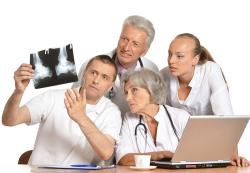 As healthcare providers face challenges from empowered patients, the increasing impact of the internet and mobile technology on patient care, and more outcomes-focused regulatory requirements, the role of information technology in healthcare has never been more important.
As healthcare providers face challenges from empowered patients, the increasing impact of the internet and mobile technology on patient care, and more outcomes-focused regulatory requirements, the role of information technology in healthcare has never been more important.
 As healthcare providers face challenges from empowered patients, the increasing impact of the internet and mobile technology on patient care, and more outcomes-focused regulatory requirements, the role of information technology in healthcare has never been more important. To both gain more perspective and to help align Popper and Company’s strategies with the latest advances and issues, I will be attending the annual HIMSS14 (Healthcare Information and Management Systems Society) conference in Orlando starting next week.
As healthcare providers face challenges from empowered patients, the increasing impact of the internet and mobile technology on patient care, and more outcomes-focused regulatory requirements, the role of information technology in healthcare has never been more important. To both gain more perspective and to help align Popper and Company’s strategies with the latest advances and issues, I will be attending the annual HIMSS14 (Healthcare Information and Management Systems Society) conference in Orlando starting next week.
At Popper and Company, we’ve helped guide our clients around a wide range of healthcare IT issues, ranging from mobile health, to patient engagement, to establishing the value of healthcare IT—all “hot topics” at this year’s HIMSS meeting. I expect that some of the issues we’ve discussed in the past will be part of this year’s conference, namely:
“Coolness” versus consumer/patient value—Without question, digital tools are “cool.” Furthermore, they are making healthcare more personalized and more accessible to a newly empowered patient/consumer. But how enthusiastic are consumers and physicians about truly integrating these digital health technologies such as smart phones, wearable sensors, cloud computing, and apps into routine care? Beyond recreational use, mainstream customers may want to see tangible value measured as improved outcome. Translating the benefits and capturing value beyond the coolness factor is the next chapter in user adoption and more importantly, in user retention.
High-tech help for low-tech issues—Some healthcare improvements are technology-intensive, be they a new drug or diagnostic device development, or health service management tool. But sometimes a nagging problem begs for a solution that’s inexpensive and relatively low-tech. Take hand-washing, for example. This simple procedure can combat the 100,000 deaths and $30 billion in annual costs attributable to hospital-acquired infections, yet it has been documented that only 30 percent of hospital staff meets the standard for hand-washing. Economic incentives (carrot and stick) open the door for innovative solutions like sensors; hospitals are increasingly motivated to pay for them given the obvious ROI for preventing such complications. Impedance-matching the technical solution to the problem remains both a challenge and an opportunity that we address by engaging with individuals who understand both at a very granular level.
Telemedicine goes mainstream?—Remote healthcare has been used in places like Australia (which contends with vast distances between provider and patient) and India (where a vast patient population surrounds too few providers). Recently, however, the increased popularity of smartphones, the improved technology of handheld devices, video transmission and changes in provider perception of data safety are making telemedicine a viable option in countries like the United States. In places like New Mexico, where patients can be far-flung, or Detroit, where patients can walk into a Rite-Aid clinic and contact a doctor via video, these technologies are easing access to healthcare.
(HIMSS 2014 / shutterstock)








